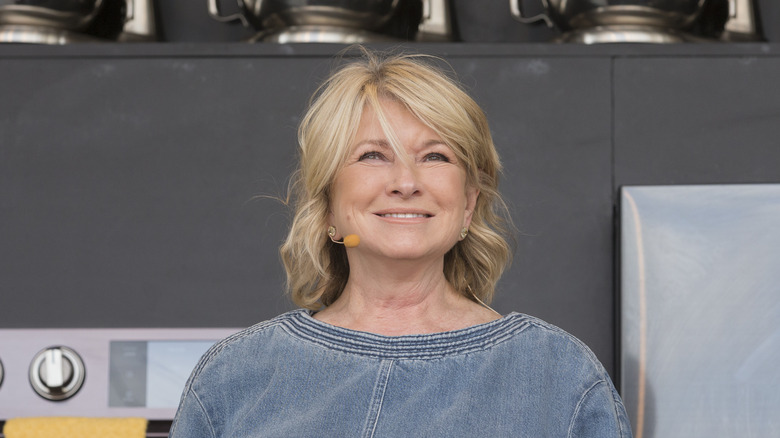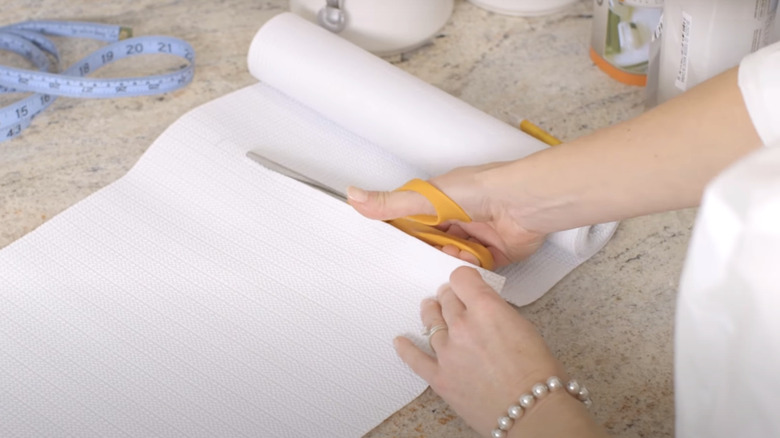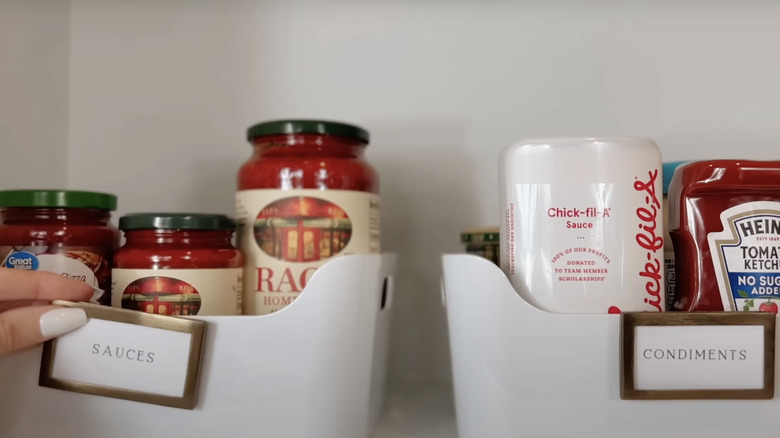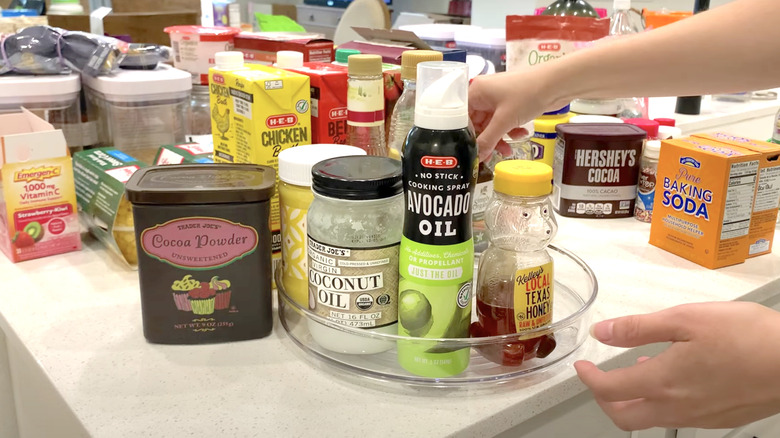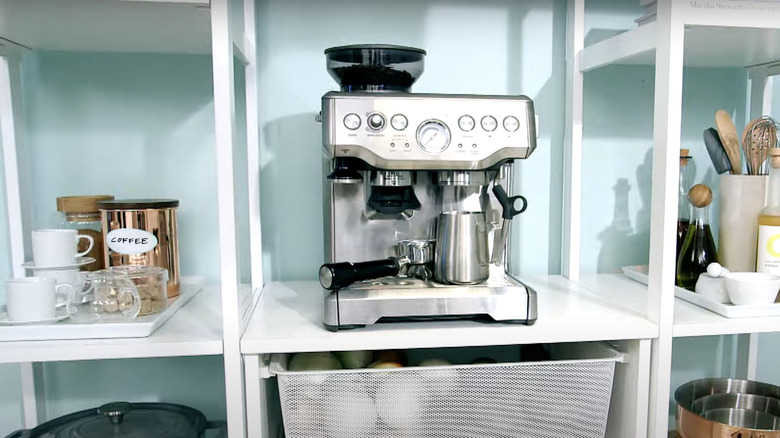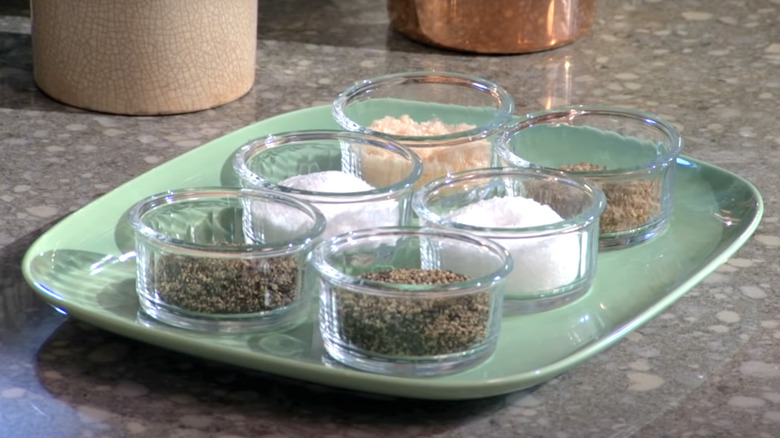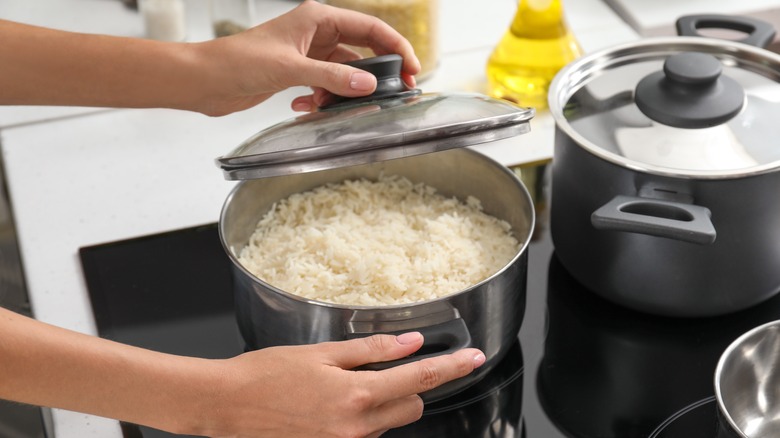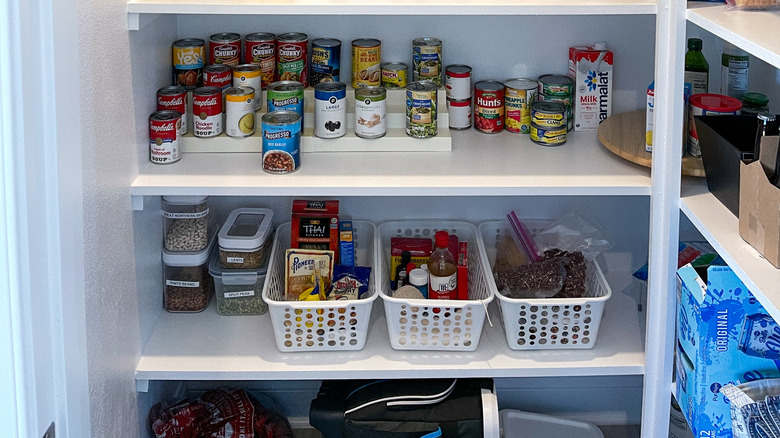Martha Stewart's Tips On How To Keep An Organized Pantry
No one re-organizes a pantry like Martha Stewart, as she's spent years sharing tips and tricks for keeping the highest-traffic location in a home neat and orderly. The beauty of her advice is that it applies to most households, and people of all income levels can use her tactics to maintain a functional kitchen.
Below are some of Martha Stewart's most popular pantry organization tips, from ideas to keep your pantry tidy to simple organization tips that will make your time in the kitchen easier and more pleasant. You can learn the logic behind her best ideas and, more importantly, discover how to apply them to your own kitchen.
Line the shelves with freezer paper
The home and lifestyle industry is full of ways to customize and organize shelves, cabinets, and drawers with niche products, and shelf liners are one of these "must-haves" for homeowners. These adhesive-backed inserts protect storage areas from stains and scratches and keep items from sliding on unfinished wood and other surfaces. All shelf liners serve the same purpose, and although they come in various colors and designs, they are mostly hidden by the items stacked on top of them. Since these liners are hardly visible and serve a functional purpose, Martha Stewart introduced an alternative solution utilizing supplies most people already have in their homes.
Instead of purchasing specialized shelf liners, this organizing aficionado made a 2019 blog post sharing how to create liners from freezer paper (via The Martha Blog). This easy DIY project requires only freezer paper, a ruler, and a pair of scissors. To get started, first measure the dimensions of your shelf with a ruler then cut the freezer paper accordingly. After dusting and cleaning off the shelves, you simply lay the paper down and re-stock your pantry items on top. In short, freezer paper is a great long-term solution for shelf lining. If it gets dirty, you can brush or wipe it clean and reuse it without any hassle. You won't need to empty your whole shelf when containers tip over and spill, just the affected section of freezer paper. And, when the freezer paper starts looking shabby, simply cut a fresh piece and dispose of the old one. This is an economical and effective solution for keeping your pantry shelves neat.
Combine like items together
Martha Stewart's advice, "Life is too complicated to not be orderly," never ceases to be relevant. In another blog post on The Martha Blog, the celebrity encouraged her followers to always group similar items together when organizing a kitchen pantry. Start by removing all items from the pantry to get an all-encompassing look at your collection of ingredients. You can then divide items by types, such as olive oils, hot sauces, jams, and honeys. Once these products are split up, group them by size, placing the smaller objects in front of the larger ones.
Arranging similar items together makes it easier to find the ingredients you're looking for, as well as keep track of lesser-used items. Martha Stewart also recommended purchasing organization trays, which often come in plastic, vinyl, silicone, and glass form, to hold smaller jars and pouches. Placing the smaller items in trays keeps them grouped when you're digging through your cooking supplies, minimizing the chance that they get lost underneath or behind larger items.
Create grouping systems unique to you
Most people don't have the vast collection of sauces, spices, oils, and other cooking ingredients that Martha Stewart has gathered over her years of traveling and merchandising. However, this isn't to say you don't have your own stockpile of preferred products that may differ from hers. In an Instagram post, Martha Stewart shared her latest "savory" pantry organization, where she stored over 40 salts, almost 30 olive oils, and more. She listed her hoard of hot sauces, barbecue sauces, Asian sauces, rices, and grains, and expressed how after re-organizing, she now knows everything she has and does not have.
Martha Stewart grouped her items to best fit her lifestyle and what she has. You can apply this organizational tip to your own life by taking account of all your favorite recipes and commonly used ingredients. You don't need to make your pantry look like Martha Stewart's, but you should establish a grouping system specific to your daily living. If you like to experiment with diverse cuisines, try arranging your ingredients by culture. On the other hand, if you're a fan of spicy food, try organizing your spices by heat and hot sauces by Scoville Heat Units (SHU). Some people even have special homemade sauce and spice mix recipes, and if you make yours often, you should place these collections together. There is no one best organization method that fits everyone, so don't be afraid to explore your options and see what works best for you and your kitchen.
Everything doesn't have to go in the main pantry
Placing all pantry items in one closet or room isn't always the most practical way to go about it. If you can't keep your pantry orderly and constantly have to dig for items, don't be afraid to spread them out in other areas of your kitchen. When Martha Stewart advertised her new pantry modular system on YouTube, she proved how items could be stored in an aesthetically pleasing manner outside of the main pantry. Martha reminds us to "Use every inch of space available to you" (via Martha Stewart).
Your main pantry is a great storage spot for the majority of your items, but consider placing extraneous goods in other cabinets, under your kitchen island, and on nearby open shelving. In her YouTube video, "Get More Room Out of Your Kitchen with These Storage Tricks," Stewart shows how she stores canned dog food alongside other pet-related supplies in the cabinets beneath her kitchen island. Actions like this free up more shelving in your main pantry for human food, and keeps these two different categories of sustenance clearly distinguished from one another. To make even more room in your pantry, you can follow tips from other influencers inspired by Martha Stewart's advice. For example, you can store aluminum foil, plastic bags, and paper products above your fridge and keep kitchen cleaning supplies under your sink, instead of mixing these non-food items with your pantry consumables.
Take ingredients out of bulky packaging
Instagram, TikTok, YouTube, and other video platforms are full of influencers and internet personalities showing off meticulously organized pantries. Many of these avid organizers follow one of Martha Stewart's most popular strategies: taking items out of their store-bought containers and placing them in glass or plastic containers. Putting spices, sugars, and flour in matching jar sets makes your pantry prettier to look at and keeps items more cohesive and tidy.
Written in the same blog post where she showed off her freezer paper liners, Martha Stewart revealed how she stored her seven different types of salt in multiple containers and labeled them accordingly. In addition to the salts, you should follow this approach for any pantry items you want to keep tidy and preserved for longer. A sealed jar with a rubber gasket is much more likely to preserve food than packets or bags, which are flimsy packaging methods that many unique spices and standard pet foods come in. As Martha Stewart explains on YouTube, "Labeled airtight containers in your pantry keeps it organized, provides visibility, and keeps everything fresher." Consider storing grains, flours, rice, spices, and sugars in this manner– you can find simple storage sets and label them yourself or order pre-labeled collections from popular sites like Amazon and Etsy.
Tape cooking instructions to the back of these jars
In "Martha Stewart's Homekeeping Handbook," Martha Stewart provides another helpful tip for pantry organization. If you follow her previous advice of removing items from bulky boxes and transferring them to more organized containers, you'll probably throw away the former packaging. Before tossing the old container in the trash, do a quick lookover for the listed cooking instructions. Unless you have the recipe and directions memorized, you're going to need it when preparing a meal later.
The public figure's home-keeping handbook explicitly advises that its readers tape the instructions for cooking rice on the inside of the lid. To be fair, cooking rice is an amateur cooking feat and only takes some water and time to make. However, different types of rice require varying water measurements and must be simmered anywhere from 15 to 60 minutes. Unless you memorize each type of rice, the water it needs, and the time it takes, you'll need the simple guidelines in front of you. Following Martha Stewart's method, you'll have the instructions in reach with your re-packed rice. What better way to avoid the inconvenience of putting cooking on hold so you can search the internet or text a friend for help? Although Martha Stewart ascribes this tip specifically to rice, it's implied that you can utilize it for other foods as well. Don't forget to cut out the instructions for other grains, such as quinoa, farro, and oats, and any other foods with uncomplicated but necessary suggestions.
Put least-used items on lower shelving
Everyone has items in their pantry that they don't use but don't want to get rid of quite yet. They're usually obscure ingredients you only used for one recipe or old spice mixes that were so spicy you're cautious about using them again. Or maybe it's a snack food that a close relative or friend enjoys, and you only keep it around for when they stop by. In any of these cases, these items aren't a part of your daily life, and there's no reason to store them with commonly used ingredients.
Once again, Martha Stewart's 2017 blog post is relevant, as she explains, "Less used items can be placed on lower shelves." However, she also advises keeping labels facing the front. If the original product labels are torn or missing, write or print homemade labels so you don't forget what ingredient is inside. Since you don't use these consumables often, they likely aren't recognizable. Keeping the labels in front makes them easier to identify, so you don't have to embark on a deep search into the darkest corners of your pantry. Her recommendations are sound, but parents should keep other considerations in mind. Small children can grab lower shelves, and parents should avoid putting sharp or glass containers within their reach. With this in mind, you may want to omit some pantry commodities from this rule.
